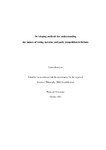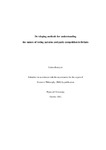Developing methods for understanding the nature of voting patterns and party competition in Britain
| dc.contributor.supervisor | Thrasher, Michael | |
| dc.contributor.author | Borisyuk, Galina | |
| dc.contributor.other | Faculty of Arts, Humanities and Business | en_US |
| dc.date.accessioned | 2013-01-22T11:59:12Z | |
| dc.date.available | 2013-01-22T11:59:12Z | |
| dc.date.issued | 2012 | |
| dc.identifier | 10433329 | en_US |
| dc.identifier.uri | http://hdl.handle.net/10026.1/1249 | |
| dc.description | Full version unavailable due to 3rd party copyright restrictions. | |
| dc.description.abstract |
This research both develops new methods and expands upon existing methodologies in order to improve our understanding of voting patterns and party competition in Britain. The thesis comprises five sections, each of which relates to a particular research focus. The first and principal section describes the process of determining a new method for decomposing electoral bias for three-party competition under simple plurality rules of voting. The study of electoral bias is important for voting systems that requires periodic boundary reviews intended to equalise electorate and to remove malapportionment. These papers describe both the process for developing the threeparty bias method and later its application to UK general elections from 1983 onwards. The second section uses aggregate data gathered for the elections to the Greater London Authority in order to understand the patterns of electoral support across the capital, particularly support for minor parties. A considerable amount of research effort has been expended upon providing reliable models for electoral forecasting both in the UK and elsewhere. The third section includes a paper that develops a forecast model that utilises aggregate local election data to estimate national vote shares for the three main parties in the UK. A fourth section brings together a series of papers that are linked by the themes of voter behaviour, either in terms of geographical or ballot context. A study of voter turnout in a London borough describes the relationship between proximity to polling station and electoral turnout at different types of election. A 8 number of papers included in this section also detail the effects of candidate ballot order on electoral support. The fifth and final section groups together two papers that using individual-level survey data to describe the pattern of candidate recruitment for local elections in Britain and, specifically, the under-recruitment of both women and Black, Asian and other minority ethnic candidates. | en_US |
| dc.language.iso | en | en_US |
| dc.publisher | University of Plymouth | en_US |
| dc.subject | British Elections | en_US |
| dc.subject | Electoral Bias | |
| dc.subject | Electoral Geography | |
| dc.subject | Third Parties | |
| dc.subject | Ward-level Aggregate Data | |
| dc.subject | Minor Parties | |
| dc.subject | Election Forecasting | |
| dc.subject | Ballot positional effect; | |
| dc.subject | Candidate survey | |
| dc.subject | Recruitment | |
| dc.subject | Under-representation | |
| dc.title | Developing methods for understanding the nature of voting patterns and party competition in Britain | en_US |
| dc.type | Thesis | |
| plymouth.version | Edited version | en_US |
| dc.identifier.doi | http://dx.doi.org/10.24382/4073 |
Files in this item
This item appears in the following Collection(s)
-
01 Research Theses Main Collection
Research Theses Main



